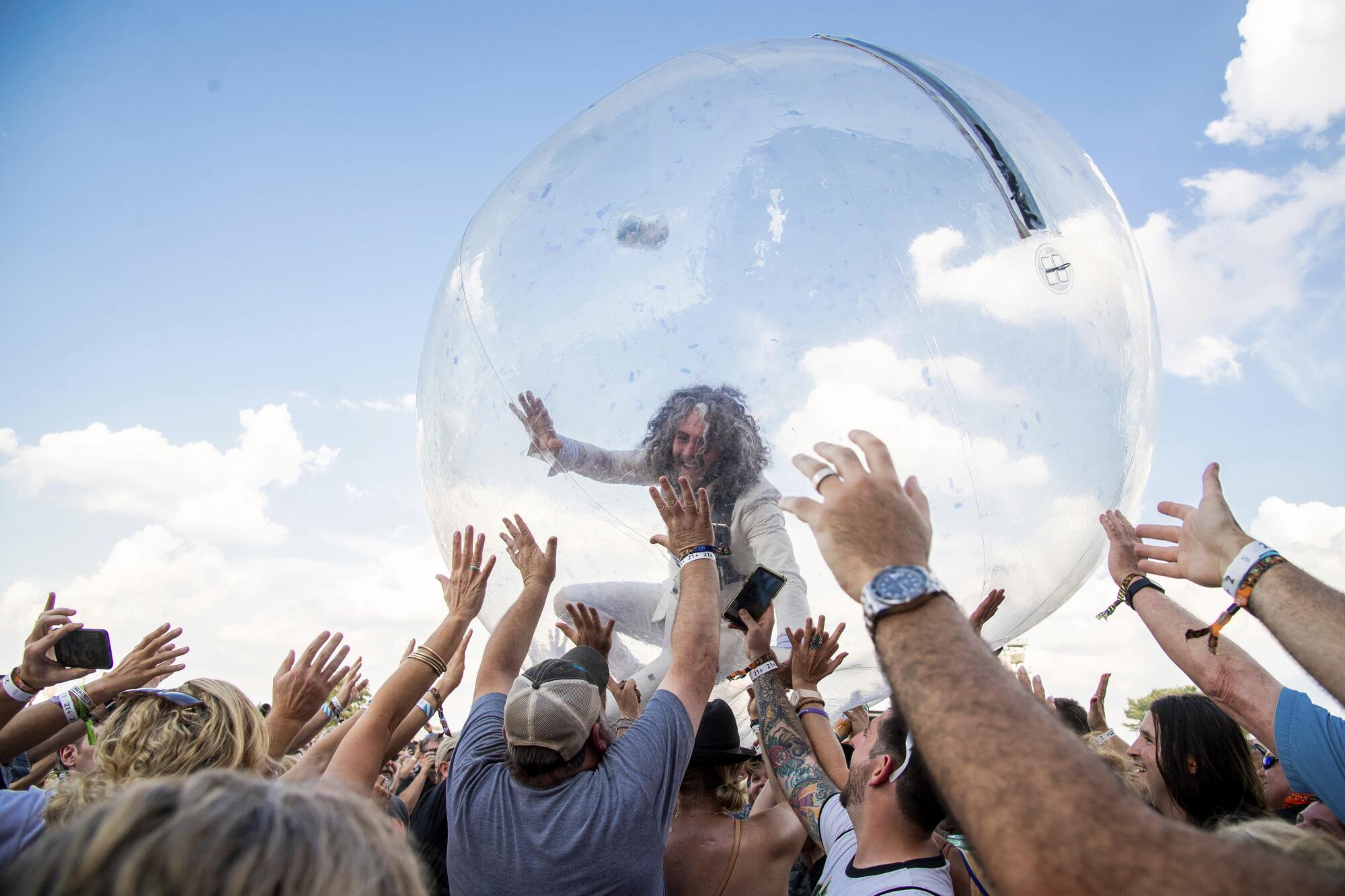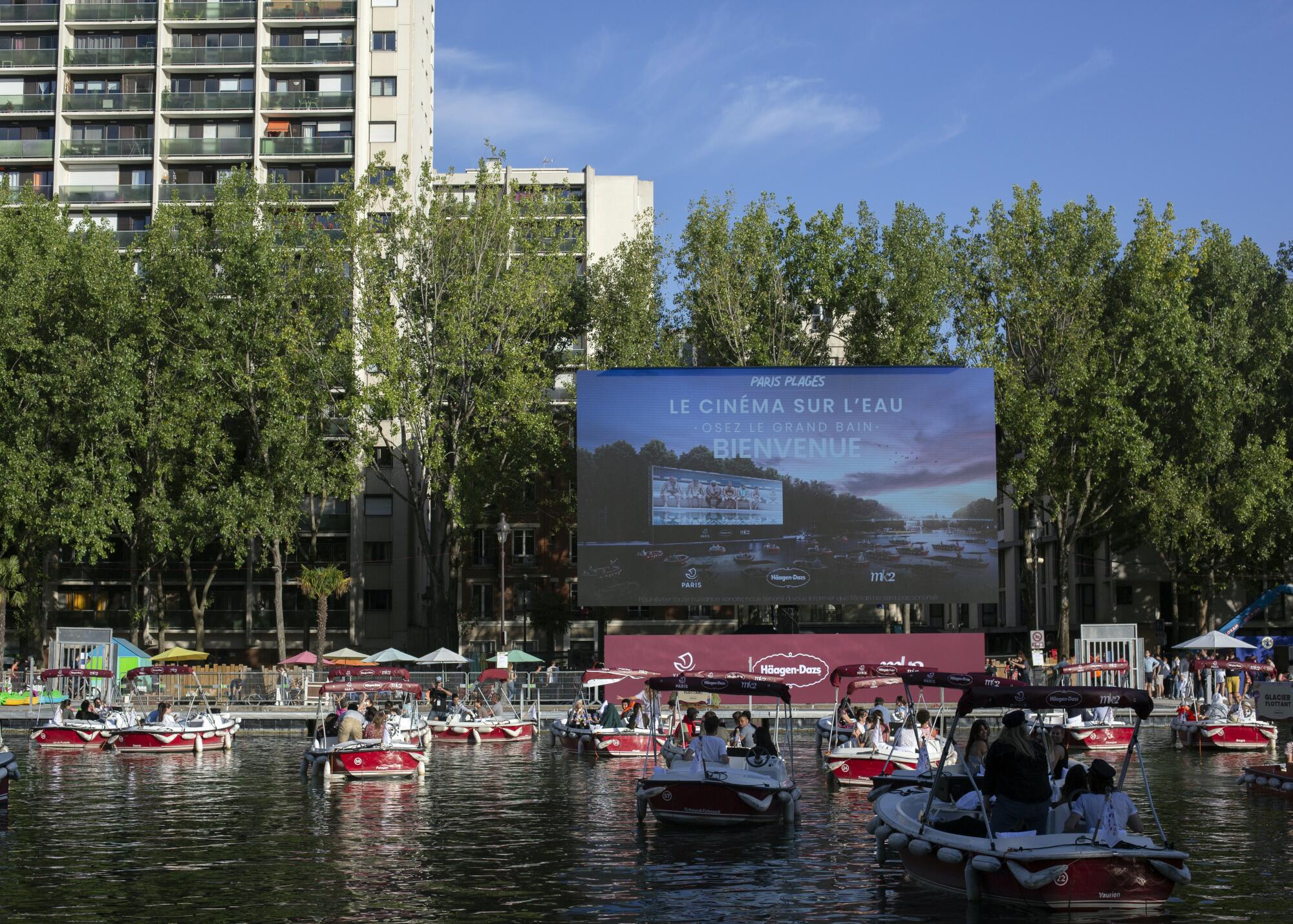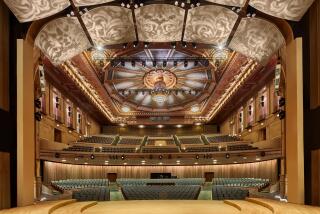- Share via
There is no silver lining to a pandemic that has killed more than 1.5 million people globally. But as COVID-19 barraged us with new challenges, it also forced adaptation that in the design world translated to faster, lighter, cheaper and more flexible buildings and landscapes. This kind of grass-roots change has been called many things: ad hoc architecture, guerrilla architecture, pop-up architecture, tactical urbanism.
Such ideas — devised by world-class designers and amateur enthusiasts alike — emerged immediately in the form of modular hospitals, mobile treatment centers and tented drive-through COVID testing sites, but they have since spilled into streets and other public spaces, taking advantage of the relative safety of the outdoors. They offer not only utility but also hope and inspiration in a supremely dark time. The quick, flexible thinking behind them has begun seeping into architecture, construction and urban design, worlds that are known for permanence, red tape, slow change and a limited sphere of practitioners.
Here are some of the best ideas that have emerged from around the world this year. They are clever and sometimes astonishing solutions from all types of creative people, solving new challenges beautifully, effectively and quickly.
Restaurants
Perhaps the field most affected by this wave of ad hoc architecture has been restaurants, which by necessity have expanded onto sidewalks, parking lots and even streets — a move enabled by quick adjustments by municipal governments worldwide. (New York, for one, made its Open Restaurants program permanent.)
The Page, San Francisco
San Francisco has long been a hub for parklets, those small parks built on street parking spots and sidewalks. The city’s dining parklets are some of the best —and most plentiful — in the country. Some have bamboo-clad walls, intricate murals, planted dividers or A-frame structures. Thanks to designer and tattoo artist Mattie Breen, who goes by Mattie B, this dive bar and pool hall in the city’s Divisadero neighborhood essentially re-created its interior outside. Breen and owner Bob Wait installed faux brick walls, fireplaces, old-time paintings, photos and plastic taxidermy. Much of the haul was taken from salvage yards, Breen’s and Wait’s personal collections, and the restaurant’s interior. Breen, who learned to build from his grandfather, a carpenter, sees the surge in creative projects as a lifeline for artists like him who are struggling during the pandemic. “When things start to get tight you really start to think about what you can do to survive,” he said.
Setaara, Atlantic City, N.J.
Afghan French restaurant Setaara in the summer took the extraordinary step of building a temporary two-story structure around a rear courtyard inspired by a Moroccan riad. Tiered plywood arches, supported by a steel frame, ring a fountain filled with rose petals and lighting imported from Morocco, Egypt and Turkey. Restaurant co-owner Abdullah Panah, whose family hails from Afghanistan, is a building enthusiast (and also a medical student at Rowan University). The design, he said, was inspired by his trips in the Middle East, particularly to Morocco and Iran. Once he gets planning approval, he and his team of builders will layer in stucco and tile cladding and add a second-floor dining space and a third-floor rooftop terrace, with views of the Atlantic City strip. So far, Panah said, the restaurant — which has installed heat lamps and fire pits for winter — is busier than it’s ever been.
Café Galleria, Midway, Utah
As the winter sets in, restaurants have taken to employing globes, igloos, greenhouses, yurts, tents or cabanas equipped with blankets, fire pits and space heaters to help diners stay warm and safe. The city of Chicago even held a competition to encourage winter dining ideas. But none is quite as beautiful as Café Galleria’s Alpenglobes, polycarbonate spheres built with curved, stained timber frames and timber flooring, and equipped with tables and benches, integrated heating, music and lighting. Reservations to dine in the so-called “reverse snow globes” on the patio are booked through February, while the restaurant and its designers, Insight Exhibits, have started a business building Alpenglobes nationwide for restaurants, hotels and even private residences.
Dine Out, New York
Relatively early in the pandemic, restaurant and hospitality specialists Rockwell Group devised — free of charge — a modular kit of parts that included flooring, barriers, shading, lighting and furniture as well as space for sanitation and equipment. The system, now being fitted with wind shields and heaters for the winter, has been employed in restaurants in all five boroughs of New York, and the outline of components is available for free download. “We never see anything like this up in Harlem. This only happens downtown,” a woman told the New Yorker, referring to Melba’s, one of Dine Out’s restaurant partners.
Another pro bono hero is Design Advocates, a New York group of affiliated architects and designers whose “Test Fits” initiative has assisted local businesses and communities adapting their spaces to COVID using simple materials, bold colors and unusual patterns.
Parks
Civic spaces are more important than ever, and many are being used in new ways. Plazas have become skate parks, green spaces have become marketplaces. A few have been dramatically, and quickly, transformed with social distancing in mind.
Domino Park, New York
One of the most photographed outdoor spaces during the pandemic has been Brooklyn’s Domino Park, hugging the East River in Williamsburg. It was transformed in May with about 30 8-foot-diameter white circles spray-painted on the artificial grass, delineating space for social distance. Park director Michael Lampariello, a landscape architect, came up with the idea after the city had threatened closure of parks, which were becoming overwhelmed by those escaping quarantine. “We thought that keeping the park open was one of the most important things we could do,” said Lampariello, who noted that the initial implementation — using a line-laying system jury-rigged for use as a compass — took about three hours. Thanks largely to social media, parks around the world followed this lead.
Checkerboard Park, Elblag, Poland
A similarly simple but elegant solution was the strategic mowing of the overgrown garden of Elblag’s Centrum Sztuki Galeria EL, an arts center that occupies a cavernous Gothic church. Gallery director Adriana Ronżewska-Kotyńska, who trained as an architect, devised the checkerboard concept to help visitors picnic on the grass. After measuring space for blankets, she realized that most were the same size (6 feet long) as social distance requirements. She made a sketch, and her only investment was paying a gardener $50 to mow the squares. The gallery moved its summer concerts, usually held inside the church, to the lawn, which became a sensation on Instagram and other media.
Cathedral Gardens Play Park, Belfast, Ireland
Most of us associate pop-ups with shopping, but COVID has prompted cities to open pop-up parks on parking lots, underused green spaces and abandoned properties. Thanks to an emergency allocation from the Belfast City Council, Cathedral Gardens Play Park rose — in less than two months — to a square next to the University of Ulster and St. Anne’s Cathedral. Designed with input from local toddlers, the park features imagination-friendly equipment like a giant spinning hamster wheel, “bendy” benches, outdoor musical instruments, a swinging bridge and colorful mushrooms on a carpet of rainbow-colored sod called Unicorn Grass. The park is expected to be up as a trial for about two years.
Streets
Cities worldwide have opened miles of thoroughfares to pedestrians, providing badly needed public space that’s often enlivened with art, play facilities and bike lanes. Others have transformed streets into green spines, exhibition spaces and town squares.
Common Ground, Jackson, Miss.
This vibrant street mural lining Duling Avenue in Jackson’s Fondren neighborhood — created by local designers Scott Allen and Casey Jennings and supported by Bloomberg Philanthropies’ Fertile Ground Project — invited a hesitant public to use the street for dining and recreation. Originally created for the “Dining on Duling” event in June, the grid of blue 8-foot squares clarifying social distance and leaving room for tables and activities is still in use. Between each square are colorful, playful shapes: Squiggly forms represent the Mississippi River, staggered lines represent chair legs, asterisk shapes represent plants, and circles represent plates. “Our community was eager to get out of their houses and socialize after three months of lockdown,” said Rebecca Garrison, executive director of the Fondren Renaissance Foundation. “We wanted to amplify the message that we were still a strong community, even though circumstances dictated a detour from the things that typically defined us.”
Tactical Urbanistas, London
This collective of artists, founded in April in London’s Hackney area, has used colorful art to enliven closed streets, reclaim parking spaces for pedestrians and encourage social distancing. Using acrylic paint, bollards and tires, the group blurs the line between open and closed space. “London’s streets are not safe for social distancing, and a disproportionate amount of space is given to cars at the expense of other road users,” a member of the group told BBC.
For those wishing to energize their own streets, Baltimore-based pavement mural specialists Graham Projects have created an online toolkit called Make Place Happen. The designers promise to carry out some of the proposals, working with local authorities.
State Street Promenade, Santa Barbara
Downtown Santa Barbara closed 10 blocks of State Street to cars in May, transforming it into the State Street Promenade. The move followed an emergency ordinance giving businesses more space for outdoor social distancing. The street and its sidewalks have since been enlivened with outdoor restaurant and bar seating, planters and music. Side streets added their own parklets, and establishments have entered into a kind of design one-upmanship to stay competitive, said Robin Elander, president of the community organization Downtown Santa Barbara. “It had been spoken about for many years, but there was never enough consensus to do it,” said Elander, who expects the street closure to continue next year and, in some form, permanently. The City Council is investigating new lighting and bike lanes.
Entertainment
Not everyone has spent the pandemic binging Netflix. Drive-in movies have made a comeback, and some of the best in California include Cinemauto in L.A.’s Chinatown, featuring film, dining and shopping; and Electric Dusk in Glendale, where you can watch flicks on the roof of a Sears parking lot, providing for great views. But these are just the beginning of the creativity that’s been spawned for those who need to get out for a mental break from home isolation.
The Flaming Lips, Space Bubble Concerts
Perhaps the most on-the-nose response to the pandemic came from the Flaming Lips, who have performed concerts with band members — and their fans — encased in human-scaled plastic bubbles. The first performance, a test run at their hometown Criterion theater in Oklahoma City in October, featured about 100 inflatable orbs, and they kicked off “space bubble concerts” at the Criterion this month with even more more orbs. “You just can’t infect the person next to you, no matter what you forget about, how excited you get,” Flaming Lips lead singer Wayne Coyne told CNN. Coyne has long been a bubble aficionado. He and his wife, Katy Weaver, were married inside one last January.

Cinema sur l’Eau
On July 18, Paris’ popular Paris Plages series — which transforms the banks of the Seine and the Canal St. Martin into temporary beaches— opened with “Cinema Sur L’eau.” Viewers watched a movie, “Le Grand Bain,” while floating on electric boats in the Bassin de La Villette. An audience watched from 38 boats while others were socially distanced in beach chairs on land.

Schools
Educators have long advocated for outdoor learning, ushering students out of their claustrophobic classrooms to get fresh air and a new perspective. The COVID crisis has made this concept more attractive particularly in warmer months, and creative designers have responded with ingenious ideas.
Prairie Hill Waldorf School, Pewaukee, Wis.
To make in-person learning more feasible, every class at Prairie Hill Waldorf School has an outdoor space for learning. Designs, devised by each class’ teacher, include indoor-outdoor tents (first grade), sukkahs (third grade) and, for fourth grade, a 12-sided outdoor classroom walled in plywood, supported by a central column and topped with a tarp — like a circus tent for learning, with large openings for fresh air to flow in and out. Learning opportunities, first-grade teacher Stanlee Maliszewski said, have widened substantially.
“Every leaf that falls, every caterpillar, every butterfly, you have to learn to make that a part of your lesson that day,” she said. The hearty Wisconsinites plan to continue using the outdoor spaces through the winter.
Curl la Tourelle Head Architecture, London
This firm has worked with tent manufacturers who normally make structures for weddings, conferences and other events; during the pandemic, they’re creating outdoor learning spaces for British schools. The architects, who are veterans of educational design, advise the schools on how to organize the new spaces, where to put them and how to keep them safe. They started with a plasticated fabric classroom at the Manorfield Primary School in London’s Tower Hamlets neighborhood, then moved to a solid-walled tent — topped with cone-shaped roofs — that acts as an outdoor dining hall for the Elsley Primary School in Wembley. (Large openings allow for natural ventilation.) They’ve developed solutions for a half-dozen schools and drawn up proposals (so far not executed) to create entire outdoor campuses. The work, senior architect Richard Taylor said, has encouraged the firm to focus on better integrating outdoor space into its future schools. The company is working with a modular builder to create timber-framed pop-up facilities that would be far better designed than most of the country’s so-called education “porta-cabins.”
At 83, the L.A. artist has hunkered down with two assistants and his dog in northern France. The goal: making more art, of course.
More to Read
The biggest entertainment stories
Get our big stories about Hollywood, film, television, music, arts, culture and more right in your inbox as soon as they publish.
You may occasionally receive promotional content from the Los Angeles Times.










